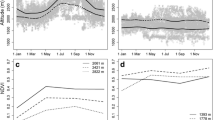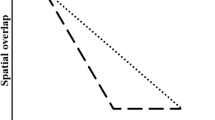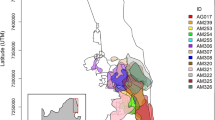Abstract
Factors affecting intraspecific variation in home range size have rarely been examined using modern statistical and remote sensing methods. This is especially true for animals in seasonal savanna environments in Africa, despite this biome’s importance for both conservation and development goals. We studied the impacts of spatial and temporal variability in environmental conditions, along with individual and social factors, on home range sizes in African buffalo (Syncerus caffer) in northeastern Namibia. Our data set spans 4 years, is derived from 32 satellite tracking collars, and contains over 35,000 GPS locations. We used the local convex hull method to estimate home range size from 31 buffalo captured at 6 sites. We used a variety of remotely sensed data to characterize potential anthropogenic and natural boundaries, as well as seasonal and temporal heterogeneity in environmental conditions. Using an information-theoretic, mixed effects approach, our analyses showed that home ranges varied over two orders of magnitude and are among the largest recorded for this species. Variables relating to vegetation and habitat boundaries were more important than abiotic environmental conditions and individual or social factors in explaining variation in home range size. The relative contributions of environmental, individual, social, and linear boundary variables to intraspecific home range size have rarely been examined and prior to this had not been assessed for any species in seasonal savannas of Africa. Understanding the factors that condition space-use patterns of wildlife in this area will lead to better-informed conservation and sustainable development decisions.


Similar content being viewed by others
References
Anderson DP, Forester JD, Turner MG, Frair JL, Merrill EH, Fortin D, Mao JS, Boyce MS (2005) Factors influencing female home range sizes in elk (Cervus elaphus) in North American landscapes. Landscape Ecol 20(3):257–271
Bar-David S, Bar-David I, Cross PC, Ryan SJ, Knechtel CU, Getz WM (2009) Methods for assessing movement path recursion with application to African buffalo in South Africa. Ecology 90(9):2467–3479
Borger L, Franconi N, De Michele G, Gantz A, Meschi F, Manica A, Lovari S, Coulson T (2006a) Effects of sampling regime on the mean and variance of home range size estimates. J Anim Ecol 75(6):1393–1405
Borger L, Franconi N, Ferretti F, Meschi F, De Michele G, Gantz A, Coulson T (2006b) An integrated approach to identify spatiotemporal and individual-level determinants of animal home range size. Am Nat 168(4):471–485
Borger L, Dalziel BD, Fryxell JM (2008) Are there general mechanisms of animal home range behaviour? A review and prospects for future research. Ecol Lett 11(6):637–650
Bro-Jorgensen J, Brown ME, Pettorelli N (2008) Using the satellite-derived normalized difference vegetation index (NDVI) to explain ranging patterns in a lek-breeding antelope: the importance of scale. Oecologia 158:177–182
Burgess N, D’Amico JH, Underwood E, Dinerstein E (2004) Terrestrial ecoregions of Africa and Madagascar: a conservation assessment. Island Press, Washington, DC
Burnham KP, Anderson D (1998) Model selection and multimodel inference: a practical information-theoretic approach. Springer, New York
Cagnacci F, Boitani L, Powell RA, Boyce MS (2010) Animal ecology meets GPS-based radio-telemetry: a perfect storm of opportunities and challenges. Phil Trans R Soc B 365:2157–2162
Calenge C (2006) The package “adehabitat” for the R software: a tool for the analysis of space and habitat use by animals. Ecol Model 197(3–4):516–519
Chammaille-Jammes S, Fritz H, Murindagomo F (2007) Climate-driven fluctuations in surface-water availability and the buffering role of artificial pumping in an African savanna: potential implications for herbivore dynamics. Austral Ecol 32:740–748
Cross PC, Lloyd-Smith JO, Getz WM (2005) Disentangling association patterns in fission-fusion societies using African buffalo as an example. Anim Behav 69:499–506
Du Toit JT, Cumming DHM (1999) Functional significance of ungulate diversity in African savannas and the ecological implications of the spread of pastoralism. Biodivers Conserv 8(12):1643–1661
Estes RD (1991) The behavior guide to African mammals. University of California Press, Los Angeles
Forester JD, Ives AR, Turner MG, Anderson DP, Fortin D, Beyer HL, Smith DW, Boyce MS (2007) State-space models link elk movement patterns to landscape characteristics in Yellowstone National Park. Ecol Monogr 77(2):285–299
Frair JL, Merrill EH, Visscher DR, Fortin D, Beyer HL, Morales JM (2005) Scales of movement by elk (Cervus elaphus) in response to heterogeneity in forage resources and predation risk. Landscape Ecol 20(3):273–287
Fryxell JM, Wilmshurst JF, Sinclair ARE (2004) Predictive models of movement by Serengeti grazers. Ecology 85(9):2429–2435
Fryxell JM, Mosser A, Sinclair ARE, Packer C (2007) Group formation stabilizes predator-prey dynamics. Nature 449(7165):1041–1043
Fryxell JM, Hazell M, Borger L, Dalziel BD, Haydon DT, Morales JM, Mcintosh T, Rosatte RC (2008) Multiple movement modes by large herbivores at multiple spatiotemporal scales. Proc Natl Acad Sci 105(49):19114–19119
Gelman A (2008) Scaling regression inputs by dividing by two standard deviations. Stat Med 27:2865–2873
Getz WM, Wilmers CC (2004) A local nearest-neighbor convex-hull construction of home ranges and utilization distributions. Ecography 27:489–505
Getz WM, Fortmann-Rose S, Cross PC, Lyons AJ, Ryan SJ, Wilmers CC (2007) LoCoH: nonparametric kernel methods for constructing home ranges and utilization distributions. PLoS ONE 2(2):e207. doi:10.1371/journal.pone.0000207
Gillies CS, Hebblewhite M, Nielsen SE, Krawchuk MA, Aldridge CL, Frair JL, Saher DJ, Stevens CE, Jerde CL (2006) Application of random effects to the study of resource selection by animals. J Anim Ecol 75:887–898
Haas EM, Bartholome E, Combal B (2009) Time series analysis of optical remote sensing data for the mapping of temporary surface water bodies in sub-Saharan western Africa. J Hydrol 370:52–63
Halley DJ, Mari M (2004) Dry season social affiliation of African buffalo bulls at the Chobe riverfront, Botswana. S Afr J Wildl Res 34(2):105–111
Halley DJ, Vandewalle MEJ, Mari M, Taolo C (2002) Herd-switching and long-distance dispersal in female African buffalo Syncerus caffer. Afr J Ecol 40(1):97–99
Hamel S, Garel M, Festa-Bianchet M, Gaillard J-M, Côté SD (2009) Spring normalized difference vegetation index (NDVI) predicts annual variation in timing of peak faecal crude protein in mountain ungulates. J Appl Ecol 46(3):582–589
Hansen MC, DeFries RS, Townshend JRG, Carroll M, Dimiceli C, Sohlberg RA (2003) Global percent tree cover at a spatial resolution of 500 meters: first results of the MODIS vegetation continuous fields algorithm. Earth Interact 7:1–15
Hebblewhite M, Haydon DT (2010) Distinguishing technology from biology: a critical review of the use of GPS telemetry data in ecology. Phi Trans R Soc B 365:2303–2312
Humphries NE, Queiroz N, Dyer JRM, Pade NG, Musyl MK, Schaefer KM, Fuller DW, Brunnschweiler JM, Doyle TK, Houghton JDR, Hays GC, Jones CS, Noble LR, Wearmouth VJ, Southall EJ, Sims DW (2010) Environmental context explains Levy and Brownian movement patterns of marine predators. Nature 465(7301):1066–1069
Jetz W, Carbone C, Fulford J, Brown JH (2004) The scaling of animal space use. Science 306:266–268
Jonsen ID, Flemming JM, Myers RA (2005) Robust state-space modeling of animal movement data. Ecology 86(11):2874–2880
Lichti NI, Swihart RK (2011) Estimating utilization distributions with kernel versus local convex hull methods. J Wildl Manag 75(2):413–422
Lindsey PA, Roulet PA, Romanach SS (2007) Economic and conservation significance of the trophy hunting industry in sub-Saharan Africa. Biol Conserv 134(4):455–469
Loarie SR, Van Aarde RJ, Pimm SL (2009a) Elephant seasonal vegetation preferences across dry and wet savannahs. Biol Conserv 142:3099–3107
Loarie SR, Van Aarde RJ, Pimm SL (2009b) Fences and artificial water affect African savannah elephant movement patterns. Biol Conserv 142:3086–3098
MacNally R (1996) Hierarchical partitioning as an interpretative tool in multivariate inference. Aust J Ecol 21:224–228
MacNally R (2002) Multiple regression and inference in ecology and conservation biology: further comments on identifying important predictor variables. Biodivers Conserv 11:1397–1401
MacNally R, Walsh CJ (2004) Hierarchical partitioning public-domain software. Biodivers Conserv 13:659–660
Marshal JP, Bleich VC, Krausman PR, Reed ML, Andrew NG (2006) Factors affecting habitat use and distribution of desert mule deer in an arid environment. Wildl Soc Bull 34(3):609–619
McLoughlin PD, Ferguson SH (2000) A hierarchical pattern of limiting factors helps explain variation in home range size. Ecoscience 7(2):123–130
McNaughton SJ, Georgiadis NJ (1986) Ecology of African grazing and browsing mammals. Annu Rev Ecol Syst 17:39–65
Melletti M, Penteriani V, Boitani L (2007) Habitat preferences of the secretive forest buffalo (Syncerus caffer nanus) in Central Africa. J Zool 271(2):178–186
Mendelsohn J, Roberts C (1997) An environmental profile and atlas of Caprivi. Gamsberg Macmillian, Windhoek
Mendelsohn J, Jarvis A, Roberts C, Robertson T (2002) Atlas of Namibia: a portrait of the land and its people. David Philip Publishers, Cape Town
Millennium Ecosystem Assessment (2005) Ecosystems and human well-being: synthesis. Island Press, Washington, DC
Moorcroft PR, Barnett A (2008) Mechanistic home range models and resource selection analysis: a reconciliation and unification. Ecology 89(4):1112–1119
Morales JM, Haydon DT, Frair J, Holsiner KE, Fryxell JM (2004) Extracting more out of relocation data: building movement models as mixtures of random walks. Ecology 85(9):2436–2445
Mueller T, Olson KA, Fuller TK, Schaller GB, Murray MG, Leimgruber P (2008) In search of forage: predicting dynamic habitats of Mongolian gazelles using satellite-based estimates of vegetation productivity. J Appl Ecol 45(2):649–658
Mulonga S, Suich H, Murphy C (2003) The conflict continues: human wildlife conflict and livelihoods in Caprivi. Ministry of Environment and Tourism, Windhoek
Murray K, Conner MM (2009) Methods to quantify variable importance: implications for the analysis of noisy ecological data. Ecology 90(2):348–355
Naidoo R, Du Preez P, Stuart-Hill G, Jago M, Wegmann M (2012) Home on the range: factors explaining partial migration of African buffalo in a tropical environment. PLoS ONE 7(5):e36527. doi:10.1371/journal.pone.0036527
Nathan R, Getz WM, Revilla E, Holyoak M, Kadmon R, Saltz D, Smouse PE (2008) A movement ecology paradigm for unifying organismal movement research. Proc Natl Acad Sci 105(49):19052–19059
Ogutu JO, Piepho H-P, Dublin HT, Bhola N, Reid RS (2008) Rainfall influences on ungulate population abundance in the Mara-Serengeti ecosystem. J Anim Ecol 77:814–829
Ogutu JO, Piepho H-P, Dublin HT, Bhola N, Reid RS (2010) Rainfall extremes explain interannual shifts in timing and synchrony of calving in topi and warthog. Popul Ecol 52:89–102
Patterson TA, Thomas L, Wilcox C, Ovaskainen O, Matthiopoulos J (2008) State-space models of individual animal movement. Trends Ecol Evol 23(2):87–94
Pettorelli N, Vik JO, Mysterud A, Gaillard J-M, Tucker CJ, Stenseth NC (2005) Using the satellite-derived NDVI to assess ecological responses to environmental change. Trends Ecol Evol 20(9):503–510
Pettorelli N, Ryan S, Mueller T, Bunnefeld N, Jedrzejewska B, Lima M, Kausrud K (2011) The normalized difference vegetation index (NDVI): unforeseen successes in animal ecology. Clim Res 46(1):15–27
Pinheiro JC, Bates DM (2000) Mixed-effects models in S and S-PLUS. Springer, New York
Polansky L, Wittemyer G, Cross PC, Tambling CJ, Getz WM (2010) From moonlight to movement and synchronized randomness: fourier and wavelet analyses of animal location time series data. Ecology 91(5):1506–1518
Prins HHT (1996) Ecology and behaviour of the African buffalo: social inequality and decision making. Chapman & Hall, London
Redfern JV, Grant CC, Gaylard A, Getz WM (2005) Surface water availability and the management of herbivore distributions in an African savanna ecosystem. J Arid Environ 63:406–424
Rivrud IM, Loe LE, Mysterud A (2010) How does local weather predict red deer home range size at different temporal scales? J Anim Ecol 79(6):1280–1295
Ryan SJ, Knechtel CU, Getz WM (2006) Range and habitat selection of African buffalo in South Africa. J Wildl Manag 70(3):764–776
Said S, Servanty S (2005) The influence of landscape structure on female roe deer home-range size. Landscape Ecol 20(8):1003–1012
Sankaran M, Hanan NP, Scholes RJ, Ratnam J, Augustine DJ, Cade BS, Gignoux J, Higgins SI, Le Roux X, Ludwig F, Ardo J, Banyikwa F, Bronn A, Bucini G, Caylor KK, Coughenour MB, Diouf A, Ekaya W, Feral CJ, February EC, Frost PGH, Hiernaux P, Hrabar H, Metzger KL, Prins HHT, Ringrose S, Sea W, Tews J, Worden J, Zambatis N (2005) Determinants of woody cover in African savannas. Nature 438(7069):846–849
Sawyer H, Kauffman MJ, Nielson RM, Horne JS (2009) Identifying and prioritizing ungulate migration routes for landscape-level conservation. Ecol Appl 19(8):2016–2025
Sinclair ARE (1977) The African buffalo: a study of resource limitation of populations. University of Chicago Press, Chicago
R Development Core Team (2008) R: A language and environment for statistical computing. ISBN 3-900051-07-0, http://www.R-project.org. Vienna, Austria
van Beest FM, Rivrud IM, Loe LE, Milner JM, Mysterud A (2011) What determines variation in home range size across spatiotemporal scales in a large browsing herbivore? J Anim Ecol. doi:10.1111/j.1365-2656.2011.01829.x
Van de Koppel J, Prins HHT (1998) The importance of herbivore interactions for the dynamics of African savanna woodlands: an hypothesis. J Trop Ecol 14:565–576
Viswanathan GM (2010) Ecology: fish in levy-flight foraging. Nature 465(7301):1018–1019
Walter WD, VerCauteren KC, Campa H, Clark WR, Fischer JW (2009) Regional assessment on influence of landscape configuration and connectivity on range size of white-tailed deer. Landscape Ecol 24(10):1405–1420
Winnie JA, Cross P, Getz W (2009) Habitat quality and heterogeneity influence distribution and behavior in African buffalo (Syncerus caffer). Ecology 89(5):1457–1468
Wittemyer G, Polansky L, Douglas-Hamilton I, Getz WM (2008) Disentangling the effects of forage, social rank, and risk on movement autocorrelation of elephants using Fourier and wavelet analyses. Proc Nat Acad Sci 105(49):19108–19113
Zeidler J, Wegmann M, Dech S (2012) Spatio-temporal robustness of fractional cover upscaling: a case study in semi arid savannah’s of Namibia and Western Zambia. SPIE Remote Sensing, Edinburgh
Zuur AF, Ieno EN, Walker NJ, Saveliev AA, Smith GM (2009) Mixed effects models and extensions in ecology with R. Springer, New York
Acknowledgments
We thank the Ministry of Environment and Tourism, Namibia, for funding, permission to capture animals in national parks (permits 1537/2010, 1339/2008, and 1184/2007), and logistical support. Erica Rieder, Carol Murphy, Julie Taylor, Ortwin Aschenborn, Vincent Guillemin, Simon Mayes, Beavan Munali, Hans Swartbooi, Bucker, Bollen Zingolo, Shadrich Siloka, Jannie du Preez, Carl-Heinz Moelle, Piet Beytell, Lise Hansen, Euan Anderson, Andrea Capobianco, Scott Loarie, Ally Thompson, Russell Taylor, and Jo Tagg assisted with field work and/or data interpretation and analysis. Special thanks to Sylvia Thompson for help in preparation of figures, and Dave Ward and Raymond Peters for interpretation of the results. We thank WWF-Germany, the Kathryn Fuller Science for Nature Fund, and the Game Products Trust Fund of Namibia for funding the field operations. Comments from Brett Goodwin and three anonymous reviewers greatly improved an earlier draft of the manuscript.
Author information
Authors and Affiliations
Corresponding author
Rights and permissions
About this article
Cite this article
Naidoo, R., Preez, P.D., Stuart-Hill, G. et al. Factors affecting intraspecific variation in home range size of a large African herbivore. Landscape Ecol 27, 1523–1534 (2012). https://doi.org/10.1007/s10980-012-9807-3
Received:
Accepted:
Published:
Issue Date:
DOI: https://doi.org/10.1007/s10980-012-9807-3




